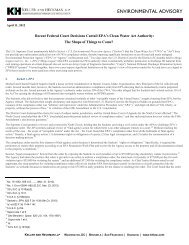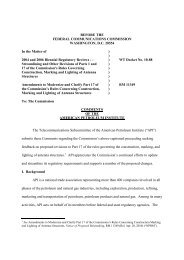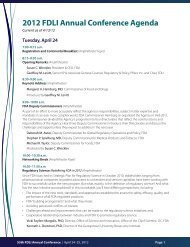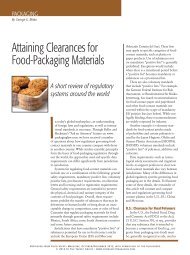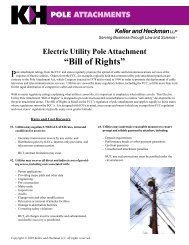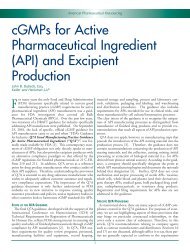A Practical Understanding of the Polymer ... - Keller Heckman
A Practical Understanding of the Polymer ... - Keller Heckman
A Practical Understanding of the Polymer ... - Keller Heckman
You also want an ePaper? Increase the reach of your titles
YUMPU automatically turns print PDFs into web optimized ePapers that Google loves.
<strong>Polymer</strong> Exemption Requirements<br />
2. Condition (e)(1)<br />
Paragraph (e)(1) covers polymers with number-average molecular weights<br />
(NAMWs) <strong>of</strong> 1000 and above but less than 10,000. At <strong>the</strong> same time, polymers in<br />
this molecular weight range also must always have a molecular weight distribution<br />
such that <strong>the</strong>re is less than 25 weight percent with molecular weights below 1000<br />
and less than 10 weight percent with molecular weights below 500. Both criteria<br />
must be simultaneously met for <strong>the</strong> condition to apply.<br />
In addition, polymers that meet <strong>the</strong> molecular weight criteria <strong>of</strong> <strong>the</strong> (e)(1) condition<br />
must also satisfy an important limitation for certain reactive functional<br />
groups (RFGs). Because this RFG limitation functions more like an exclusion, it is<br />
discussed below with o<strong>the</strong>r exclusions.<br />
3. Condition (e)(2)<br />
Paragraph (e)(2) covers polymers with molecular weights <strong>of</strong> 10,000 or greater.<br />
The concomitant requirements for molecular weight distribution are oligomer contents<br />
<strong>of</strong> less than five weight percent with molecular weights less than 1000 and<br />
less than two weight percent with molecular weights less than 500.<br />
Essential Molecular Mass Data<br />
Condition MW min MW max %




